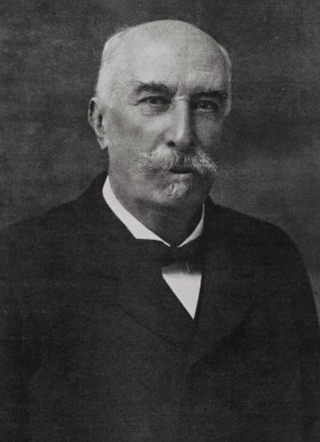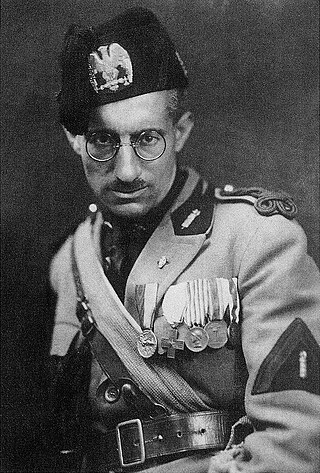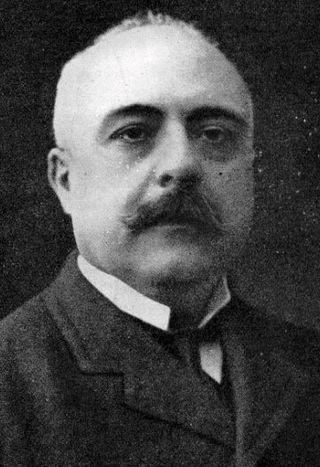Related Research Articles

Gaetano Salvemini was an Italian socialist and anti-fascist politician, historian, and writer. Born in a family of modest means, he became an acclaimed historian both in Italy and abroad, particularly in the United States, after he was forced into exile by Benito Mussolini's Italian fascist regime.

Giovanni Giolitti was an Italian statesman. He was the prime minister of Italy five times between 1892 and 1921. He is the longest-serving democratically elected prime minister in Italian history, and the second-longest serving overall after Benito Mussolini. A prominent leader of the Historical Left and the Liberal Union, he is widely considered one of the most powerful and important politicians in Italian history; due to his dominant position in Italian politics, Giolitti was accused by critics of being an authoritarian leader and a parliamentary dictator.

The March on Rome was an organized mass demonstration in October 1922 which resulted in Benito Mussolini's National Fascist Party ascending to power in the Kingdom of Italy. In late October 1922, Fascist Party leaders planned a march on the capital. On 28 October, the fascist demonstrators and Blackshirt paramilitaries approached Rome; Prime Minister Luigi Facta wished to declare a state of siege, but this was overruled by King Victor Emmanuel III, who, fearing bloodshed, persuaded Facta to resign by threatening to abdicate. On 30 October 1922, the King appointed Mussolini as Prime Minister, thereby transferring political power to the fascists without armed conflict. On 31 October the fascist Blackshirts paraded in Rome, while Mussolini formed his coalition government.

Michele Bianchi was an Italian revolutionary syndicalist leader who took a position in the Unione Italiana del Lavoro (UIL). He was among the founding members of the Fascist movement. He was widely seen as the dominant leader of the leftist, syndicalist wing of the National Fascist Party. He took an active role in the "interventionist left" where he "espoused an alliance between nationalism and syndicalism." He was one of the most influential politicians of the regime before his succumbing to tuberculosis in 1930. He was also one of the grand architects behind the "Great List" which secured the parliamentary majority in favor of the fascists.

This article covers the history of Italy as a monarchy and in the World Wars. The Kingdom of Italy was a state that existed from 17 March 1861, when Victor Emmanuel II of Sardinia was proclaimed King of Italy, until 2 June 1946, when civil discontent led to an institutional referendum to abandon the monarchy and form the modern Italian Republic. The state resulted from a decades-long process, the Risorgimento, of consolidating the different states of the Italian Peninsula into a single state. That process was influenced by the Savoy-led Kingdom of Sardinia, which can be considered Italy's legal predecessor state.

Antonio Salandra was a conservative Italian politician, journalist, and writer, who served as the 21st prime minister of Italy between 1914 and 1916. He ensured the entry of Italy in World War I on the side of the Triple Entente to fulfil Italy’s irredentist claims.

Alessandro Fortis was an Italian politician who served as the 18th prime minister of Italy from 1905 to 1906.
Red Week was the name given to a week of unrest which occurred from 7 to 14 June 1914. Over these seven days, Italy saw widespread rioting and large-scale strikes throughout the Italian provinces of Romagna and the Marche.

The Kingdom of Italy was a state that existed from 17 March 1861, when Victor Emmanuel II of Sardinia was proclaimed King of Italy, until 12 June 1946, when the monarchy was abolished, following civil discontent that led to an institutional referendum on 2 June 1946. This resulted in a modern Italian Republic. The kingdom was established through the unification of several states over a decades-long process, called the Risorgimento. That process was influenced by the Savoy-led Kingdom of Sardinia, which was one of Italy's legal predecessor states.
The New Orleans general strike was a general strike in the U.S. city of New Orleans, Louisiana, United States, that began on November 8, 1892. Despite appeals to racial hatred, black and white workers remained united. The general strike ended on November 12, with unions gaining most of their original demands.

James Duncan was a Scottish American union leader, and president of the Granite Cutters' International Association from 1895 until his death in 1928. He was an influential member of the American labor movement, helping to co-found the American Federation of Labor.

The Banca Romana scandal surfaced in January 1893 in Italy over the bankruptcy of the Banca Romana, one of the six national banks authorised at the time to issue currency. The scandal was the first of many Italian corruption scandals, and discredited both ministers and parliamentarians, in particular those of the Historical Left and was comparable to the Panama Canal Scandal that was shaking France at the time, threatening the constitutional order. The crisis prompted a new banking law, tarnished the prestige of the Prime Ministers Francesco Crispi and Giovanni Giolitti and prompted the collapse of the latter's government in November 1893. The scandal led also to the creation of one central bank, the Bank of Italy.

National syndicalism is a far-right adaptation of syndicalism to suit the broader agenda of integral nationalism. National syndicalism developed in France in the early 20th century, and then spread to Italy, Spain, and Portugal.
Events from the year 1901 in Italy.
Events from the year 1904 in Italy.
Events from the year 1905 in Italy.
Events from the year 1914 in Italy.
Events from the year 1911 in Italy.
Events from the year 1913 in Italy.
Fascist syndicalism was an Italian trade syndicate movement that rose out of the pre-World War II provenance of the revolutionary syndicalist movement led mostly by Edmondo Rossoni, Sergio Panunzio, Angelo Oliviero Olivetti, Michele Bianchi, Alceste De Ambris, Paolo Orano, Massimo Rocca, and Guido Pighetti, under the influence of Georges Sorel, who was considered the "'metaphysician' of syndicalism". The fascist syndicalists differed from other forms of fascism in that they generally favored class struggle, worker-controlled factories and hostility to industrialists, which lead historians to portray them as "leftist fascist idealists" who "differed radically from right fascists." Generally considered one of the more radical fascist syndicalists in Italy, Rossoni was the "leading exponent of fascist syndicalism", and sought to infuse nationalism with "class struggle".
References
- ↑ Clark 1984, pg. 173–174
- ↑ Goodway, David (2013). For Anarchism (RLE Anarchy). Routledge. p. 50. ISBN 978-1-135-03756-7.
Bibliography
- Clark, Martin (2014) [1984]. Modern Italy, 1871 to the Present. London/New York: Routledge.